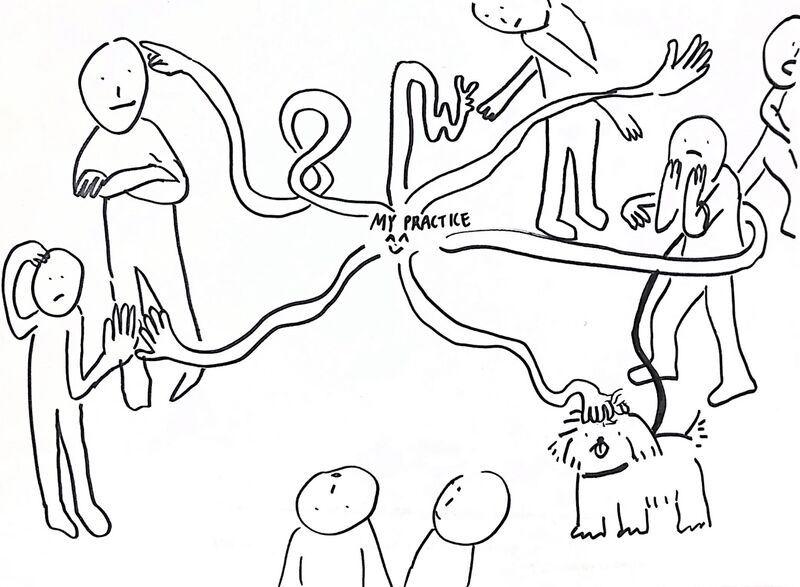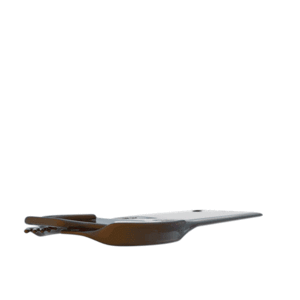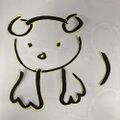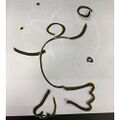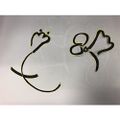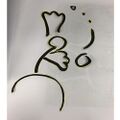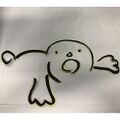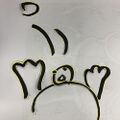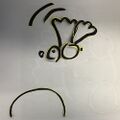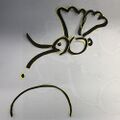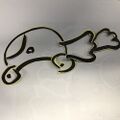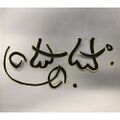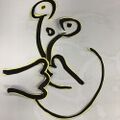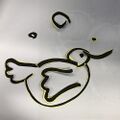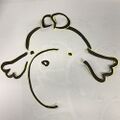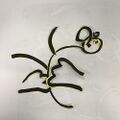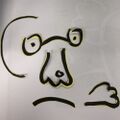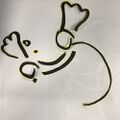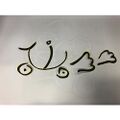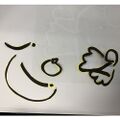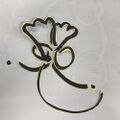User:Chae0: Difference between revisions
| Line 32: | Line 32: | ||
===Invite to be intimate=== | ===Invite to be intimate=== | ||
Leaning towards inviting and creating intimacy | Leaning towards inviting and creating intimacy | ||
==sharing== | |||
"Sharing, therefore, is not understood as an act of disclosure but instead of signals collaboration and collaborative ways to enact and engender struggle." [Dear Science, Curiosities, Katherine McKittrick]<br> | |||
sharing your [[User:Chae0#Drawing / Illustration / Annotation | note]] as an act of care | |||
===Blowing candles|dandelions|feathers|and hot tea=== | ===Blowing candles|dandelions|feathers|and hot tea=== | ||
Revision as of 15:17, 21 September 2022
hello ✋ I am Chaeyoung Kim
Chaeyoung Kim (she/her) is an interdisciplinary artist encompassing video, installation, performance and an art educator based in Seoul and Rotterdam. Her work draws on the aesthetics of cuteness such as bright colors, wobbly movements, high-pitched sounds to instigate ‘cute affects’ and encourage social interaction. Her extensive work experience as an art educator has made her aware of how curriculum content and workshops can be useful tools for positively impacting the local community.
website
kimchaeyoung.com (I did not pay for the domain so it's down atm)
self-portrait
During the self-study week, Nor organized the workshop called 'Collaboration, Conflict, Consent workshop'. During the workshop, we were asked to make a self-portrait about what excites us and what scares us. ʕʘ‿ʘʔ Also, the drawing underneath is an illustration of how I imagine my practice is or do to people.
Special Issue Log
SI 16 - Vernacular Language Processing
- ETC Portal to Contamination (Final Endpoint)
- etc_Filter / Negative Space / Starting Point (Research Log)
- SI 16 - Vernacular Language Processing (Research log for overall semester)
SI 17 - Productive Play
- SI 17 - Productive Play (Research Log)
- https://issue.xpub.nl/17/index.html (SI 17 Main Webpage)
- Fage Not Pound (Documentation of the launch of SI17)
- Karaoke_reading (Group Contribution, Can Gaming Make A Better World?)
- https://media.xpub.nl/2022/SI17/karaoke-Final.mp4 (SI17, Can Gaming Make A Better World?)
SI 18 - Radio Implicancies
- SI 18 - Radio Implicancies - Chae's research log
- Critical and Intimate Evaluation of Crunchiness - with Erica Grrrrrr
- Writing Weekly - with Kimberley
keywords? gestures? images?
actions (verbs)
Invite to be intimate
Leaning towards inviting and creating intimacy
sharing
"Sharing, therefore, is not understood as an act of disclosure but instead of signals collaboration and collaborative ways to enact and engender struggle." [Dear Science, Curiosities, Katherine McKittrick]
sharing your note as an act of care
Blowing candles|dandelions|feathers|and hot tea
한 템포 쉬고 나아가는 그 스텝이 좋은 것 같아. 물론 무엇을 부느냐에 따라 바람에 대한 반응(깃털의 흩날림, 민들레씨의 퍼짐)도 재미있지만.
Drawing / Illustration / Annotation
- a thought relates to annotation: https://pad.xpub.nl/p/writing-points-chae (wip)
- post-card making
highlight
- Sparkling of the sun on different surfaces
- 햇빛가루
- highlighting the text / deleting the text - with Gersande, Nested Narrative
- eco-lighter from 3rd semester, Radio Implicancies, making notes and reading excerpts
Licking the edge of the envelope | stamp
licking the thin paper, edge with your chunky tongue is quite funny and intimate
edible glue→ tongues that follow the lines, colored tongues
whispering
state (adjective)
Cuteness
Maybe cuteness is not the best way to wrap up my practice...! Still need to think about it.
Elements Of Surprise
flatness occupying the space, 2D->3D playing with and twisting one's expectation
flatness
번데기에서 나온 나비의 날개는 착착 접힌 낙하산처럼, 쭈글쭈글 구겨진 편지처럼 뭉쳐 있었다. 녀석들이 번데기에서 나오는 모습을 내 눈으로 보고서도 그렇게 큰 날개가 그렇게 좁은 공간에 담겨 있다는 사실이 믿기지 않았다. 갓 우화한 나비는 몸통이 뚜렷이 눈에 들어왔다. 일단 날개가 펼쳐져서 그 생명체를 압도하게 되면 이후에는 다시 볼 수 없는 모습이었다. 그 짧은 순간 나비는 꼭 벌레처럼, 곤충처럼 보였다. 감각을 느낄 줄 아는 꽃의 사촌인 양 화려한 날개로만 보이는 나중의 모습과는 달랐다. 몸통은 우화 후 몇 분 안에 날개로 펌프질해 넣어서 날개를 날기에 알맞은 평면으로 펼쳐내는 데 쓸 체액을 머금고 있기 때문에 아직 통통했다. 나비들이 각자의 번데기에 달라붙어 있는 동안, 그들의 날개가 거의 알아차릴 수 없을 만큼 서서히 펼쳐졌다. 번데기에서 완전히 빠져나오지 못해서 날개가 영영 다 펼쳐지지 않는 녀석도 있었다. [Rebecca Solnit, A field guide to getting lost]
margin
Leaving enough margins to allow readers to annotate.
marginalized
materiality
Materials
what kind of mood does each material give you?
time / temporality
attachment doll
애착 인형 = 사실은 시간과 기억에 대한 애착이 아닐까?
애착 이형에 대한 작업은 사라 아흐메드의 행복의 약속: 불행한 자들을 위한 문화 비평을 읽으면서 디벨롭시킬 것.
한나 아렌트는 이를 다음과 같이 설명한다. "약속이란 미래를 규제하는 인간만의 독특한 방식으로, 인간적으로 가능한 한에서 미래를 예측 가능하고 신뢰할 수 있는 것으로 만든다."
topic pantry
I don't know which method would be suitable for my wiki page: Have this tagging underneath?; Or having keywords on my main page so that I can always refer to things that I'm interested in? Hmm. Need some time to think about it and clean things up.
cuteness | elements of surprise | gaining trust | Hiccups | mosquitos | pockets | walking | harry potter qr code butterflies | butterfly | attachment doll | noise cancelling | flatness | emoticons | hands | 손톱 먹은 쥐 이야기, 지하철에서 봤었던 인조 손톱을 붙이는 한 여성, 지하철에 떨어진 인조 손톱
Reading List
- Minor Feelings by Cathy Park Hong
- Queer Phenomenology: Orientations, Objects, Others by Sara Ahmed
- The Promise of Happiness by Sara Ahmed
행복은 우리와 가까운 영역, 우리 주변을 형성하고 있는 세계를 친숙한 것들의 세계로 만드는 데 결정적 역할을 한다. 우리에게 쾌락을 주는 대상들은 우리의 신체적 지평 안에 둥지를 튼다. 우리가 좋아하는 것들likes을 갖게 된다는 것은 우리가 무엇과 같은지 like를 확립하는 일이다. 신체적 지평이란 좋아하는 것들의 지평이다. "우리가 좋아하는 것들"을 가진다는 건 어떤 것들이 우리 주변에 모인다는 뜻이다. 물론, 우리는 새로운 것들과 마주치기도 한다. 새로운 것들에 개방적이라는 것은 우리가 그것들을 우리와 근접한 영역으로 흡수하는 데 개방적이란 뜻이다. 흡수할지 말지는 우리가 마주친 그것을 좋아하느냐에 달려 있다. 좋아하지 않는 것들로부터 우리는 거리를 둔다. 거리두기를 통해 우리는 우리 지평의 가장자리를 확립한다. [사라 아메드 행복의 약속: 불행한 자들을 위한 문화비평, 1장]
- The Aesthetics and Affects of Cuteness edited by Edited ByJoshua Paul Dale, Joyce Goggin, Julia Leyda, Anthony McIntyre, Diane Negra
- Dear Science by Katherine McKittrick
Wonder
(...)Dear Science argues that black people have always used interdisciplinary methodologies to explain, explore, and story the world, becuase thinking and writing and imagining across a range of texts, disciplines, histories, and genres unselttles suffocating and dismal and insular racial logics. By employing interdisciplinary methodologies and living interdisciplinary worlds, black people bring together various sources and texts and narratives to challenge racism. Or, black people bring together various sources and texts and narratives not to capture something or someone, but to question the analytical work of capturing, and the desire to capture, something or someone. (...) Within black studies and anticolonial studies, one can observe an ongoing method of gathering multifariously textured tales, narratives, fictions, whispers, songs, grooves. The texture offer one way to challenge the primacy of evidentiary and insular normalcies, because they are allegedly incongruous. In assembling ideas that are seemingly disconnected and uneven (the seabird and the epilogue, the song and the soil, the punch clock and the ecosystem, the streetlight and the kick-on-beat), the logic of knoeing-to-prove is unsustainable because incongruity appears to be offering atypical thinking. Yet curioisity thrives. (...) Also, assembling ideas that are seemingly connected () fuse and break apart how we know, necause we seek out continuities and ruptures. And curiosity thrives. (...) What is meaningful, then, are the ways in which black people are interdisciplinary actors, continually entangling and disentangling varying narratives and tempos and hues that, together, invent and reinvent knowledge.
FOOTNOTES
Black studies engenders, shares, and demands diasporic literacy; black studies theorizes black liberation not through categories (identity) but from the perspective of struggle (struggle is entangled with identities-places-embodiments-infrastructures-narratives-feeling).
THE SMALLEST CELL REMEMBERS A SOUND
If we are committed to anticolonial thought, our starting point must be one of disobedient relationality that always questions, and thus is not beholden to, normative academic logics.(...)The project of making discipline overwhelmingly only gives us two options for the study of black people--to describe racism and resist racism; these options rarely have any noise or curiosity or questions about black life interrupting them. (...) Method-making is the generating and gathering of ideas--across-with0outside-within-against normative disciplines--that seek out liberation within our present system of knowledge. The goal is not to find liberation, but to seek it out.
SOMETHING THAT EXCEEDS ALL EFFORTS TO DEFINITIVELY PIN IT DOWN
(...)The question of stories and storytelling illuminate the method of collaboration. I learned from working with her. I learned from her that sharing stories engenders creative rigorous radical theory. Wait. I learned from her that sharing stories is creative rigorous radical theory. The act of sharing stories is the theory and the methodology. The process is difficult to make sense of in terms of the process and praxis of collaboration as affective possibility. Every time we speak on the telephone, I have my pen in hand, but I do not always use it. We share ideas, and stories, and our histories, and part of this collaboration was her generously sharing ideas that I wrote down because I believed them with all my heart. And lucky for me, she believed me too. (We must believe each other; we must believe the stories we tell one another.) I guess what I am trying to write but cannot pinpoint is that the collaborative aspects of the work allowed us to share ideas in ways that I did not anticipate. The project is, then, not solely text; it is the unpublishable work of conversing over several years and continuing that conversation. I did not expect to be this patient. The conversation is forever and it is forever rewound very fast and then replayed; "The friendship itself, a form of life that cannot be totally capitalized on and is therefore slightly in excess of work as we know it.... Working in friendship could be a way to work outside of productivity demands."
FAILURE(MY HEAD WAS FULL OF <ISTY FUMES OF DOUBT)
(...)To put it simply, solving crimes often involves surveying and marking black and/or impoverished geographies and claiming that this is not profiling because places, rather than people, are being targeted. In other words, social problems are resolved through producing calculations, equations, and problem-solving operations; these problems (black people) are translated into cartographically itemized racial codes. Part of our task, then, is to notice how algorithms have a place and take place and produce place and how blackness--where we know from--understands and reorders these geographies. I also focus on geography to dislodge crude identity politics, to cast the net beyond the individual and to emphasize that where we know from--rather than what we already know about seemingly authentic selves--is a more generous and difficult political project that takes into account interhuman geographies. (...) With this in mind, I suture a black sense of place to these mathematics and problem-solving practices in order to unthink the violence that often accompanies the production of space. (...) The work and process of the coding conceals a long biocentric statistical history that continues to define "traits"--out genetic characteristics--as variables. A variable is a symbol that represents a quantity in a mathematical expression. What unfolds are measurable numbers--often abstracted from human input--calculating resolutions that we care about. /n If we understand algorithms in this vein, we can begin to tease out how numbers and mathematical equations are tied to a biocentric system if knowledge. What becomes increasingly clear, then, is not simply that the results and answers racist (e.g., your traits mathematically result in your incarceration), but that the work of administrating algorithms (e.g., what we do to solve the problems that we care about) requires biocentric methods and methodologies that can only produce dehumanizing mathematical results.(...)What comes into clear view, then, is not simply the racist result but the administrative and methodological steps that require racism before they begin to work through and towards the problem. (...) Geography matters because it functions to illuminate how algorithmic answers to our problems--what we care about--are embedded in place. Interestingly, the more we research these connections between geography and algorithms, the more we notice how the former, geography, is racially codified. Predictive algorithms are not only imitating a racist system, they are refusing an already refused black humanity by marking black geographies predictably criminal. (...) Part of our intellectual task, then, is to work out how different kinds and types of texts, voices, and geographies relate to each other and open up unexpected and surprising ways to talk about liberation, knowledge, and history, race, gender, narrative, and blackness. [이 챕터 특히 딸꾹질 / 그리고 phonetree에 대한 수피와의 아이디어랑 관련되어 있음을 강하게 느껴. 왜 그렇게 느끼는지 정리해서 적어둘것 2022.08.01]
- Writing Down The Bones by Natalie Goldberg
- Sianne Ngai
- Wendy Chen
- Dictee, Teresa Hakyung Cha
- Eros in the library
- Xpub thesis
&others
Drawing and Doodle
Dear Science의 Footnote에서 본 것과 같이 나도 드로잉 묶음집에 어울리는 보여주기의 방식을 생각해 볼 것. Loop로 돌리는 것이 나을지. 아니면 격자 형태로 나오게 할 것인지, 아니면 랜덤하게 화면 위에 배치된다든지. 등등... 방학동안 드로잉들 모으고, 스캔하고, 키워드별로 분류하기(일단 모으는게 더 중요할듯).
Workshop with Raphaël Bastide
- https://pad.xpub.nl/p/workshop-with-raphael-bastide-day-1
- https://raphaelbastide.com/fragile-forge/
- https://dinakelberman.com/ author of https://dinakelberman.tumblr.com/
- http://all-html.net/ (evan roth)
- Olia lialina http://art.teleportacia.org/
- https://www.are.na/federico-poni/art-www-u_ndl6mro1y
- http://www.likeneveralways.com/ - www.likeneveralways.com/uninspiredminimalistgraphicsandharmonica3D/
- SVG to coordinate (then you can turn it to html elements) https://spotify.github.io/coordinator/ https://evasive.tech/34/
- https://lab.raphaelbastide.com/minutehack/ (CSS RESET: ignore defult style sheet)
Personal Wiki Link
- https://en.wikipedia.org/wiki/Blind_men_and_an_elephant
- https://en.wikipedia.org/wiki/Gelatin (Gelatin)
- https://en.wikipedia.org/wiki/Thickening_agent (roux, potato starch, etc.)
One choice but a well-picked choice. If you want to work with the sun and moisture chose either one.
Keep it simple. That is the way that the project will be strong. Things that ppl can emotionally connect to. Get to the core.
You are taking digital things to say digital things. There is no friction. There is no contrast.
Questions
Q1 Which image do you choose?
Q2 How this image will get old and die eventually?
Notes:
Depending on which material I chose, it will change how time effects will be different. 예컨대 페인트칠이면 벗겨지는 것일테고, 혹은 녹이 스는 것일테고 아니면 눅눅해지고 잉크가 번지는 것일수도 있겠고, 아니면 시커매지면서 손때가 묻는 것 일수도 있겠고,(마우스 커서 손가락을 또 이용할 수 도 있겠고)
Magical Button (working title)
- https://hub.xpub.nl/soupboat/constr/magical-button/ (Final Endpoint)

